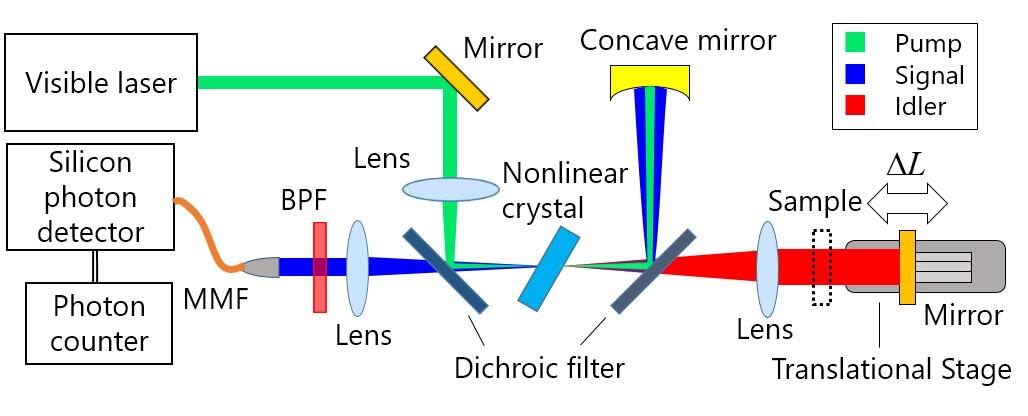It has been roughly 100 years since the quantum revolution of Einstein, Bohr, and Schrödinger. But today, a second quantum revolution is taking place. As part of this revolution, a new method of analysis has been developed that applies quantum entanglement to use visible light for infrared spectroscopy. A research group comprised of Professor Shigeki Takeuchi, Associate Professor Ryo Okamoto, researchers Yuu Mukai and Toshiyuki Tashima, and graduate students including Masaya Arahata, of the Graduate School of Engineering, Kyoto University, has proposed and tested Quantum Fourier-transform Infrared Spectroscopy that achieves infrared spectroscopy through the detection of visible light alone by leveraging the light interference due to quantum entanglement. The results will assist in creating smaller and more sensitive devices. Takeuchi states that, "We are currently engaged in joint research with Shimadzu Corporation, and we will move forward with the testing of infrared spectroscopic measurements at longer wavelengths, as well as device miniaturization." The results have been published in the journal Physical Review Applied.

Infrared spectroscopy is used in a wide range of domains, including everything from science, bioscience, and medicine, to environmental monitoring and factory production, as a method for identifying the types of molecules present in a substance. However, existing devices use lamps and other light emitters with low energy conversion rates as the infrared light source, and the devices must be cooled with liquid nitrogen to increase their sensitivity, making it difficult to reduce the size of devices, or use more sensitive silicon based detectors (CMOS sensors have the sensitivity roughly five to six orders of magnitude higher than the infrared photodetectors).
Accordingly, quantum infrared absorption spectrometers have become a subject of focus. These devices use light sources and detectors in the visible light range, enabling infrared absorption spectroscopy, which would allow a great degree of miniaturization and higher sensitivity. Unfortunately, standard quantum infrared absorption spectroscopy requires spectrometers for visible light to measure the infrared absorption spectrum, causing the devices to be much larger and more expensive.
In response, the research group proposed Quantum Fourier-Transform Infrared Spectroscopy (QFTIR) as a solution. Under this method, measurement is possible using only a single element visible light detector, without using a spectrometer, enabling the measurement of not only the absorption spectrum, but the refractive index spectrum as well.
By entering photon into a non-linear optical crystal, a pair of photons with a quantum correlation between the two frequencies, including a signal photon (visible light) and an idler photon (infrared), are generated as a result of parametric down conversion. If these are reflected and passed through another non-linear optical crystal, the quantum mechanical interference occurs with the entangled photons, and they either cancel each other out or strengthen each other. If the idler photon is shed on the measured object before passing through the second crystal, the quantum interference is broken, and the visible light photon is detected. Because of the quantum correlation between the signal and idler photons, the signal photon is affected when the idler photon is passing through the measured object, allowing the visible signal photon to be measured, which in turn allows the measurement of the infrared absorption spectrum.
A laser in the visible light spectrum is focused and reflected on a wavelength filter before being passed through the non-linear optical crystal. It is then directed to a wavelength filter that only passes infrared light, which is applied to the specimen, and reflected on a mirror placed behind the specimen. Meanwhile, the light reflected from the wavelength filter that only passes infrared light is reflected on the mirror, passing through the second non-linear optical crystal along with the infrared light. If the mirror reflecting the infrared light is made adjustable, the relative phase can be altered to measure the number of visible photons produced. Accordingly, the number of photons changes, and an interference fringe occurs, if the specimen position is changed.
It was thus theoretically determined that by applying a Fourier transformation to the interference fringe, it was possible to obtain the infrared absorption spectrum of a medium placed in the path of the infrared photons, and even the refractive index spectrum, which had been difficult to measure using standard Fourier-Transform Infrared Spectroscopy (FTIR).
The group built an actual test system and applied visible laser light with a wavelength of 810 nanometers to a non-linear optical crystal (lithium niobate) to generate infrared light with a wavelength of 1,500 nanometers. By doing so, they were able to successfully measure the absolute transmission spectrum of an optical filter with known optical properties, as well as the refractive index spectrum and extinction coefficient (an indicator of light absorption) of quartz glass. By combining the absorption spectrum, refractive index spectrum, and the extinction coefficient, it is possible to analyze the component ratio, density, and concentration of numerous substances.
Takeuchi explains that, "QFTIR has many applications, including pharmaceutical production control, and measuring the octane number at gas stations. We were able to make the prototype small enough to fit in a box 60 x 40 cm, but in the future it will likely be as small as a smartphone for use in on site environmental monitoring."
This article has been translated by JST with permission from The Science News Ltd.(https://sci-news.co.jp/). Unauthorized reproduction of the article and photographs is prohibited.




